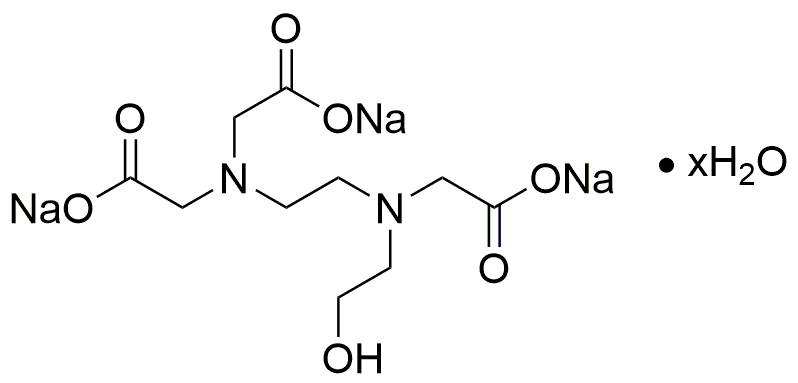N-(2-Hydroxyethyl)ethylenediaminetriacetic acid trisodium salt hydrate is widely utilized in research focused on:
- Metal Ion Chelation: This compound effectively binds to metal ions, making it valuable in various applications such as water treatment and metal recovery processes. It helps in removing heavy metals from wastewater, thereby improving environmental safety.
- Pharmaceutical Formulations: Its chelating properties are beneficial in pharmaceutical formulations, particularly in stabilizing metal-containing drugs. This enhances drug efficacy and shelf life, making it a preferred choice in the pharmaceutical industry.
- Biochemical Research: In laboratories, it is used as a buffer component in biochemical assays, helping to maintain pH levels. This is crucial for experiments involving enzymes and proteins, ensuring accurate results.
- Cosmetic Products: The compound is incorporated into cosmetic formulations to improve skin hydration and stability. Its ability to chelate metal ions helps prevent oxidative damage, enhancing product longevity and effectiveness.
- Food Industry Applications: It serves as a food additive to bind trace metals, which can otherwise catalyze spoilage reactions. This application is particularly important in preserving the quality and safety of food products.
General Information
Properties
Safety and Regulations
Applications
N-(2-Hydroxyethyl)ethylenediaminetriacetic acid trisodium salt hydrate is widely utilized in research focused on:
- Metal Ion Chelation: This compound effectively binds to metal ions, making it valuable in various applications such as water treatment and metal recovery processes. It helps in removing heavy metals from wastewater, thereby improving environmental safety.
- Pharmaceutical Formulations: Its chelating properties are beneficial in pharmaceutical formulations, particularly in stabilizing metal-containing drugs. This enhances drug efficacy and shelf life, making it a preferred choice in the pharmaceutical industry.
- Biochemical Research: In laboratories, it is used as a buffer component in biochemical assays, helping to maintain pH levels. This is crucial for experiments involving enzymes and proteins, ensuring accurate results.
- Cosmetic Products: The compound is incorporated into cosmetic formulations to improve skin hydration and stability. Its ability to chelate metal ions helps prevent oxidative damage, enhancing product longevity and effectiveness.
- Food Industry Applications: It serves as a food additive to bind trace metals, which can otherwise catalyze spoilage reactions. This application is particularly important in preserving the quality and safety of food products.
Documents
Safety Data Sheets (SDS)
The SDS provides comprehensive safety information on handling, storage, and disposal of the product.
Product Specification (PS)
The PS provides a comprehensive breakdown of the product’s properties, including chemical composition, physical state, purity, and storage requirements. It also details acceptable quality ranges and the product's intended applications.
Certificates of Analysis (COA)
Search for Certificates of Analysis (COA) by entering the products Lot Number. Lot and Batch Numbers can be found on a product’s label following the words ‘Lot’ or ‘Batch’.
*Catalog Number
*Lot Number
Certificates Of Origin (COO)
This COO confirms the country where the product was manufactured, and also details the materials and components used in it and whether it is derived from natural, synthetic, or other specific sources. This certificate may be required for customs, trade, and regulatory compliance.
*Catalog Number
*Lot Number
Safety Data Sheets (SDS)
The SDS provides comprehensive safety information on handling, storage, and disposal of the product.
DownloadProduct Specification (PS)
The PS provides a comprehensive breakdown of the product’s properties, including chemical composition, physical state, purity, and storage requirements. It also details acceptable quality ranges and the product's intended applications.
DownloadCertificates of Analysis (COA)
Search for Certificates of Analysis (COA) by entering the products Lot Number. Lot and Batch Numbers can be found on a product’s label following the words ‘Lot’ or ‘Batch’.
*Catalog Number
*Lot Number
Certificates Of Origin (COO)
This COO confirms the country where the product was manufactured, and also details the materials and components used in it and whether it is derived from natural, synthetic, or other specific sources. This certificate may be required for customs, trade, and regulatory compliance.


